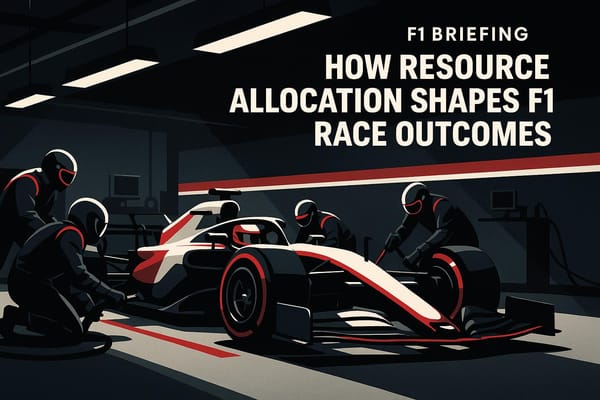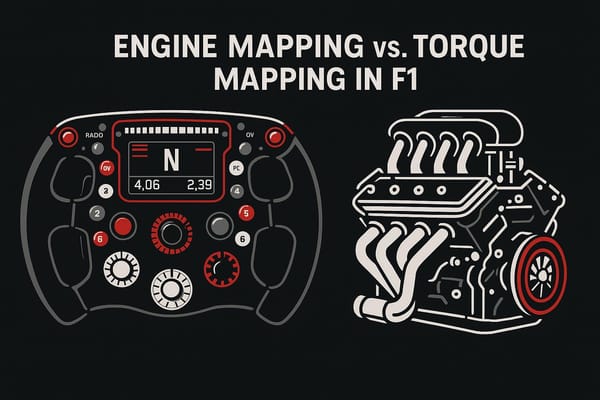Inside the Pit: How F1 Transmission Affects Tire Wear and Fuel Efficiency
Explore how F1 transmission systems impact tire wear and fuel efficiency, shaping race strategies and performance outcomes.

In Formula 1, transmission systems are more than just gearboxes - they directly influence tire wear, fuel efficiency, and overall race strategy. Here's what you need to know:
- Gear Ratios: Shorter ratios boost acceleration but stress tires, while longer ratios favor top speed and conserve fuel.
- Shifting Techniques: Precise shifts reduce torque spikes, preventing tire damage and improving fuel economy.
- Telemetry Data: Teams analyze real-time data to adjust transmission settings, balancing speed, tire longevity, and fuel use.
- Team Strategies: Top teams like Mercedes and Red Bull optimize transmission setups for specific tracks, while others struggle to match their precision.
Modern F1 transmissions, with their lightning-fast shifts and seamless power delivery, are key to managing resources during races. Every gear change impacts performance, making transmission strategies critical for success.
How Formula 1 Gearboxes Work (F1 team explains)
F1 Transmission Systems Explained
Formula 1 transmission systems are marvels of engineering, designed to transfer engine power to the rear wheels with pinpoint accuracy in some of the most demanding conditions imaginable. These systems operate with split-second precision, ensuring every ounce of power is used effectively. Let’s dive into the key components and unique features of F1 gearboxes.
Main Parts of F1 Transmissions
At the core of an F1 transmission are three essential components: the gearbox, differential, and driveshaft. Together, they manage the immense power generated by modern F1 engines and ensure it reaches the wheels efficiently.
The gearbox alone is a masterpiece of engineering, packing over 500 parts into a unit that weighs less than 88 pounds. It’s built to handle extreme stress and adheres to FIA regulations, featuring between four and eight forward gears, plus a mandatory reverse gear.
Drivers control gear changes using paddle shifters located behind the steering wheel. These paddles are linked to an advanced electro-hydraulic system, which not only manages gear shifts but also integrates throttle and clutch control. At the heart of this system is a sophisticated electronic control unit that processes driver inputs and executes commands with incredible accuracy.
"The two primary functions of any gear case are to rigidly mount the bearings of any gear shafts, such that the gears maintain accurate meshing under the parting loads induced as they transmit torque, to keep dirt out, and to keep lubricating oil in."
What Makes F1 Gearboxes Different
F1 gearboxes stand apart from standard transmissions in several key ways. They use a sequential shifting system with a rotating drum mechanism, allowing drivers to shift up or down only one gear at a time. This design ensures consistent and predictable shifts, which are critical for maintaining stability at high speeds.
The speed of these gear changes is astonishing - shifts occur in just 10–15 milliseconds. Modern F1 cars utilize seamless gearboxes, which virtually eliminate power loss during shifts. This smooth power delivery not only enhances performance but also reduces stress on the drivetrain.
The gearbox casing itself plays a dual role, also serving as a mounting point for the rear suspension. Constructed from materials like aluminum, magnesium, titanium, and carbon fiber, these casings are designed to be both incredibly strong and lightweight. Operating under extreme conditions, F1 gearboxes can reach temperatures as high as 266°F (130°C) while transmitting up to 3,688 lb-ft (5,000 Nm) of torque to the final drive.
"A gearbox is a carefully cultured, very secret high-tech product, and its 400 individual parts are all specially produced for each team - right down to the bearings and seals. Naturally, that all has its price: a Formula 1 gearbox, according to expert estimates, costs about 150,000 euros."
These intricate designs and cutting-edge materials not only make F1 gearboxes unique but also directly impact how teams approach race strategy.
How Transmissions Shape Race Strategy
Transmission settings are a critical aspect of race strategy. Teams must fine-tune these settings for each circuit, balancing power and efficiency to maximize performance. FIA regulations limit the number of gear ratios teams can use over a season, making these decisions vital for achieving championship success.
Aerodynamics also play a significant role in gearbox design. The shape and placement of the transmission affect airflow around the rear of the car, influencing cooling and overall aerodynamic efficiency. These factors, combined with precise calibration for straight-line speed and cornering acceleration, highlight the crucial role transmissions play in the world of Formula 1.
Gear Ratios: Finding the Right Balance
Gear ratios are a critical component in determining whether an F1 car excels in acceleration or reaches blistering top speeds. These mathematical relationships between gears dictate how engine power translates into wheel torque, directly influencing tire wear and fuel efficiency during a race. Let’s dive into how these ratios work and their impact on performance.
How Gear Ratios Work in F1
In Formula 1, gear ratios are all about trade-offs. Shorter gear ratios amplify torque, enabling quick acceleration out of tight corners. On the other hand, longer ratios are designed for top speed and better fuel efficiency.
Teams tailor gear ratios to the unique demands of each circuit. For instance, Monaco’s twisty, narrow streets require shorter ratios to power through its sharp corners, while Monza’s high-speed straights demand longer ratios to maximize velocity.
The process of selecting the perfect gear ratios is no small feat. Teams analyze over 1,000 data points every second and run millions of simulations to fine-tune their setups. Engineers consider everything from the track layout to aerodynamic performance and grip levels. This meticulous balancing act not only determines acceleration but also sets the tone for how the car interacts with the track surface.
How Gear Ratios Affect Tire Wear
The connection between gear ratios and tire wear is more significant than it might seem. Uneven or poorly chosen gear ratios can lead to excessive wheelspin and torque stress, both of which accelerate tire degradation. Teams must carefully balance the need for acceleration and top speed while factoring in variables like track conditions, weather, and tire performance.
What works during a cool practice session might wreak havoc on race day when track temperatures rise and grip diminishes. For example, at the 2024 Italian Grand Prix, Charles Leclerc’s team optimized gear ratios to support a one-stop strategy, preserving tire life and ensuring consistent performance. Additionally, smooth and precise gear shifts play a vital role in reducing stress on the tires, helping them last longer under race conditions.
Gear Ratios and Fuel Consumption
Gear ratios also have a direct impact on fuel efficiency. While engine mapping is a key factor, the right gear ratios ensure smooth power delivery and help reduce fuel consumption. Longer ratios are particularly effective on tracks with extended straights, allowing cars to maintain high speeds without overtaxing the engine.
To manage fuel use, teams implement advanced strategies that optimize gear shifting and monitor gearbox temperatures. Overheating can lead to lubrication issues and increased internal friction, which wastes fuel. By adjusting gear ratios during pit stops to adapt to evolving track conditions, engineers can fine-tune fuel consumption throughout the race.
Interestingly, even small changes in rolling resistance can have a noticeable effect. A 30% increase in rolling resistance, for example, can lead to an additional 3–5% in fuel consumption. This makes it clear why gear ratio optimization must align closely with tire management strategies to achieve peak performance across the board.
Shifting Methods and Performance Impact
Continuing our dive into gear ratios, let’s now look at how shifting techniques play a role in managing tire wear and fuel efficiency. Just like gear ratios, the way gears are shifted can significantly influence race results by striking a balance between performance and resource management. Today’s advanced semi-automatic systems not only allow for lightning-fast gear changes but also help teams optimize how tires and fuel are used throughout a race weekend.
Semi-Automatic Systems in F1
Modern Formula 1 cars rely on semi-automatic sequential gearboxes, operated through paddle shifters, to deliver quick and seamless gear changes. These systems ensure the car stays in its ideal power range with every shift.
The precision of these gearboxes allows for smooth power delivery, which reduces the chances of tire slip and excessive wear. By keeping the engine consistently engaged, these transmissions also maintain engine efficiency. This efficiency translates into better fuel economy and less strain on drivetrain components, which ultimately helps protect the tires from unnecessary stress.
How Poor Shifting Damages Tires
Imprecise shifting can cause torque spikes, which momentarily reduce traction and accelerate tire wear. Even a brief wheelspin generates extra heat, leading to uneven wear patterns. Additionally, inconsistent shifting can disrupt the car’s balance, forcing drivers to make steering adjustments. These corrections increase lateral forces on the tires, which can result in flat spots or localized damage.
To address these risks, teams put a strong emphasis on training drivers to perform precise shifts during practice sessions. This level of precision helps minimize tire slip and wear by ensuring each gear change happens at the right moment. Not only does this protect the tires, but it also contributes to better fuel efficiency.
Smart Shifting Saves Fuel
Strategic shifting plays a key role in reducing fuel consumption. By keeping the engine within its most efficient RPM range, drivers can cut fuel usage without compromising lap times. Timing is everything here: shifting too early wastes potential power, while shifting too late burns extra fuel. While semi-automatic systems deliver consistent shift timing, effective fuel-saving still demands careful planning based on the track layout and race conditions.
Teams also employ techniques like lift-and-coast - easing off the throttle before braking - to reduce tire stress and prevent overheating. Proper tire pressure is another critical factor, monitored through sensors and real-time data. Some teams even use systematic tire warming methods to avoid rapid degradation, which could lead to unexpected pit stops and disrupt carefully planned fuel-saving strategies.
Team Transmission Strategies Compared
When it comes to Formula 1, transmission strategies aren't just about shifting gears - they're a key factor in deciding race outcomes. Each team tailors its transmission setup to align with its broader strategy, balancing factors like tire longevity and fuel efficiency. These differences highlight how unique approaches can play a pivotal role in race performance.
How Teams Approach Transmission Setup
Red Bull Racing has earned its reputation for exceptional race management by blending meticulous strategy with drivers skilled at controlling race pace. Their transmission setup prioritizes consistent power delivery while giving drivers the flexibility to adapt to real-time conditions. This adaptability often proves crucial in races where tire degradation becomes a major challenge.
Mercedes takes a data-heavy approach, collecting over 1,000 data points every second and running more than 2 million simulations to refine their transmission strategies. This precision allows them to fine-tune settings that optimize both tire wear and fuel consumption, giving them an edge in efficiency and consistency.
Ferrari focuses on maximizing early-race performance with an aggressive transmission setup. While this strategy can deliver impressive results during a single stint, it sometimes comes at the expense of long-term tire management. When executed well, it can create opportunities to dominate the early phases of a race.
In contrast, teams like Haas often struggle with tire wear due to less advanced transmission setups. This highlights the gap between the top teams and mid-field competitors, where balancing transmission settings with tire preservation remains a challenge.
These varied strategies demonstrate how transmission setups directly impact race outcomes, with each team leveraging its strengths to gain an advantage.
Real Race Examples and Data
Fuel efficiency is a critical factor in transmission strategy. Every kilogram of fuel adds roughly 0.03 seconds per lap, so teams must carefully balance power output with fuel consumption. To ensure compliance, the FIA monitors fuel flow rates 2,200 times per second, enforcing the 100 kg per hour limit.
Tire management also varies widely among drivers and teams. Some drivers excel at extending tire life, while others experience quicker degradation. These differences often reflect how well teams integrate their transmission strategies with overall car setups and driver training.
Transmission Strategy Comparison Table
Here's a quick breakdown of how leading teams approach transmission strategies, highlighting their focus and strengths:
| Team | Primary Focus | Tire Management Approach | Fuel Efficiency Priority | Key Strength |
|---|---|---|---|---|
| Red Bull Racing | Race pace management | Driver-focused adaptability | High | Strategic flexibility |
| Mercedes | Data-driven optimization | Predictive modeling | Very High | Real-time adjustments |
| Ferrari | Early race performance | Aggressive single-stint | Medium | Peak performance windows |
| Haas | Basic optimization | Reactive management | Medium | Cost-effective approach |
Top teams rely heavily on telemetry data to monitor engine efficiency and transmission behavior, enabling quick adjustments during races. This ability to adapt in real time often separates the leaders from the rest of the field, as they can fine-tune their strategies to match evolving track conditions and tire performance.
Key Takeaways for Race Strategy
Grasping how transmission systems influence tire wear and fuel efficiency is a game-changer for race strategy. Building on earlier discussions of gear ratios and shifting techniques, top-performing teams excel by balancing outright speed with efficient resource management.
Adjusting strategies to fit specific tracks is critical. Rear-limited circuits like Bahrain and Monza call for a different approach than front-limited tracks such as Spa-Francorchamps and Interlagos. On rear-limited tracks, the focus is on managing acceleration zones and avoiding wheelspin. In contrast, front-limited circuits demand precision in braking zones and corner entry speeds. This understanding paves the way for fine-tuning transmission settings to suit the unique demands of each track.
One effective way to manage tire wear through transmission tuning is adjusting the on-throttle differential setting. Lowering this setting helps reduce wheelspin, allowing for more aggressive acceleration without overheating the tires. This adjustment not only minimizes tire temperature spikes but also extends tire life, a crucial factor in long races.
Telemetry plays a vital role in modern race strategies. By monitoring tire temperature and wear in real time, teams can make informed adjustments to their transmission settings during critical moments. Quick interpretation of this data often separates the top teams from the rest of the field.
However, data alone isn't enough. Teams must remain adaptable, considering variables like track conditions, weather changes, tire degradation, race distance, and starting position. Being able to pivot mid-race - whether due to sudden weather shifts, unexpected incidents, or evolving tire performance - can be the difference between a podium finish and falling behind.
Driver input is also a key piece of the puzzle. A smooth, controlled driving style complements optimized transmission settings, helping to extend tire life. When a driver’s natural style aligns with finely tuned transmission settings, it creates a seamless package that delivers consistent performance throughout the race.
Ultimately, teams that weave together gear ratio adjustments, shifting techniques, and telemetry insights into a cohesive strategy consistently outperform those with a less integrated approach. Every gear shift, differential tweak, and strategic decision plays a role in maximizing tire longevity and fuel efficiency, proving that attention to detail is what wins races.
FAQs
How do F1 teams use telemetry to fine-tune transmission settings during a race?
How F1 Teams Use Telemetry for Performance
F1 teams depend heavily on telemetry to keep an eye on real-time data during a race. This includes critical metrics like gear changes, engine behavior, and drivetrain performance. The continuous flow of information gives engineers the ability to fine-tune transmission settings, such as gear shift timing and control strategies, to get the most out of the car.
These real-time adjustments are crucial for adapting to shifting track conditions, managing tire wear, and boosting fuel efficiency. With telemetry, teams can make quick, informed decisions that sharpen their race strategy and keep the car performing at its best.
How do gear ratios in F1 impact tire wear and fuel efficiency?
Gear ratios in Formula 1 play a key role in managing tire wear and fuel efficiency by controlling how power is transferred to the wheels. A taller gear ratio, designed for higher speeds, keeps the engine running at lower RPM. This not only helps save fuel but also reduces tire strain during extended stints. On the flip side, a shorter gear ratio boosts acceleration but pushes the engine to higher RPM, which can lead to increased fuel consumption and faster tire wear.
Teams meticulously fine-tune gear ratios to match race conditions, aiming for the ideal balance between conserving tires and optimizing fuel use. This careful adjustment ensures cars perform effectively across various stages of the race, whether it’s maximizing speed on straightaways or maintaining durability during longer runs.
How do gear shifting techniques influence tire wear and overall performance in Formula 1?
Gear shifting techniques are a key factor in controlling tire wear and improving performance in Formula 1. When drivers execute smooth and precise gear changes, they help keep tire temperatures steady, which minimizes stress on the tires and extends their lifespan. This approach allows drivers to maintain better grip and sustain strong performance over longer stretches of a race.
However, aggressive or poorly timed gear shifts can have the opposite effect. They can lead to uneven tire wear and overheating, causing the tires to degrade more quickly. To strike the right balance, drivers must pair effective shifting techniques with smart tire management. This combination ensures they can push their cars to the limit without sacrificing tire durability.




